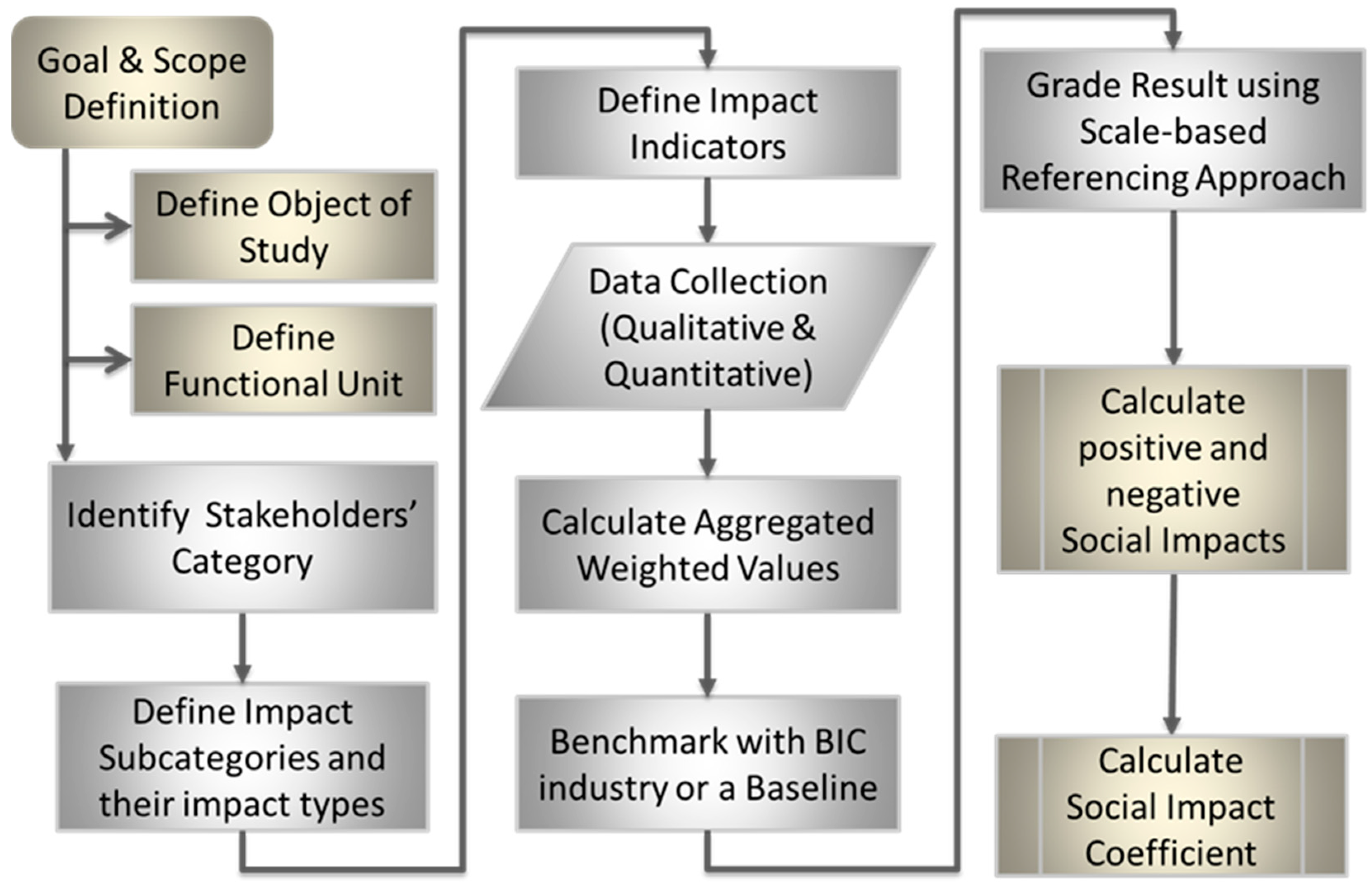Identification and Alignment of the Social Aspects of Sustainable Manufacturing with the Theory of Motivation
Abstract
1. Introduction
2. The Importance of Social Impacts Assessment in a Product Lifecycle
2.1. Social Life Cycle Assessment
2.2. Social Impacts Assessment and Social Impact Subcategories
3. Social Impacts and Motivations at Workplace
4. The Theory of Reciprocity and Employees’ Productivity
4.1. Social Economy and Social Exchange Theory
4.2. Job Satisfaction and Productivity
4.3. Herzberg Two-Factor Motivational Theory and the Social Aspects
5. Alignment of Social Impacts Assessment (SIA) with Herzberg Two-Factor Theory
5.1. The Role of Legislation and Regulations in the Alignment Process
5.2. Social Initiatives and Economic Growth
How do we measure the level of a corporate commitment to social values, or the employees’ productivity level as related to social sustainability?
5.3. Productivity Factor and Social Impact Coefficient (β)
6. Application of the Aligned Framework to Calculate Social Impact Coefficient
6.1. Hypothetical Scenario of a Simple Manufacturing Company
6.1.1. A Step-By-Step Approach to SIC Calculation
6.1.2. Calculation of the Social Impact Coefficient
6.2. Discussion and Summary
7. Conclusions
Author Contributions
Conflicts of Interest
References
- United Nations Environmental Program (UNEP). Towards a Life Cycle Sustainability A Ssessment: Making Informed Choices on Products; United Nations Environmental Program (UNEP): Nairobi, Kenya, 2011; ISBN 9789280731750. [Google Scholar]
- Brundtland, G.H. Our Common Future: Report of the World Commission on Environment and Development. Med. Confl. Surviv. 1987, 4, 300. [Google Scholar] [CrossRef]
- Zamagni, A.; Pesonen, H.-L.; Swarr, T. From LCA to Life Cycle Sustainability Assessment: Concept, practice and future directions. Int. J. Life Cycle Assess. 2013, 18, 1637–1641. [Google Scholar] [CrossRef]
- Gu, W.; Chhajed, D.; Petruzzi, N.C.; Yalabik, B. Quality design and environmental implications of green consumerism in remanufacturing. Int. J. Prod. Econ. 2015, 162, 55–69. [Google Scholar] [CrossRef]
- Valdivia, S.; Ugaya, C.M.L.; Hildenbrand, J.; Traverso, M.; Mazijn, B.; Sonnemann, G. A UNEP/SETAC approach towards a life cycle sustainability assessment—Our contribution to Rio+20. Int. J. Life Cycle Assess. 2013, 18, 1673–1685. [Google Scholar] [CrossRef]
- Gbededo, M.A.; Liyanage, K.; Garza-reyes, J.A. Towards a Life Cycle Sustainability Analysis: A Systematic Review of Approaches to Sustainable Manufacturing. J. Clean. Prod. 2018. [Google Scholar] [CrossRef]
- Jayal, A.D.; Badurdeen, F.; Dillon, O.W.; Jawahir, I.S. Sustainable manufacturing: Modeling and optimization challenges at the product, process and system levels. CIRP J. Manuf. Sci. Technol. 2010, 2, 144–152. [Google Scholar] [CrossRef]
- Eastwood, M.D.; Haapala, K.R. A unit process model based methodology to assist product sustainability assessment during design for manufacturing. J. Clean. Prod. 2015, 108, 54–64. [Google Scholar] [CrossRef]
- G??nsch, J. A note on a model to evaluate acquisition price and quantity of used products for remanufacturing. Int. J. Prod. Econ. 2015, 169, 277–284. [Google Scholar] [CrossRef]
- Wang, Q.; Li, J.; Yan, H.; Zhu, S.X. Optimal remanufacturing strategies in name-your-own-price auctions with limited capacity. Int. J. Prod. Econ. 2014, 181, 113–129. [Google Scholar] [CrossRef]
- Zhu, Z.; Wang, K.; Zhang, B. Applying a network data envelopment analysis model to quantify the eco-efficiency of products: A case study of pesticides. J. Clean. Prod. 2014, 69, 67–73. [Google Scholar] [CrossRef]
- Nabavi-Pelesaraei, A.; Abdi, R.; Rafiee, S.; Mobtaker, H.G. Optimization of energy required and greenhouse gas emissions analysis for orange producers using data envelopment analysis approach. J. Clean. Prod. 2014, 65, 311–317. [Google Scholar] [CrossRef]
- Cataldo, A.; Taisch, M.; Stahl, B. Modelling, simulation and evaluation of energy consumptions for a manufacturing production line. In Proceedings of the Industrial Electronics Society, IECON 2013—39th Annual Conference of the IEEE, Vienna, Austria, 10–13 November 2013; pp. 7529–7534. [Google Scholar]
- Cropanzano, R.; Mitchell, M.S. Social Exchange Theory: An Interdisciplinary Review. J. Manag. 2005, 31, 874–900. [Google Scholar] [CrossRef]
- UNEP Setac Life Cycle Initiative. Guidelines for Social Life Cycle Assessment of Products; UNEP Setac Life Cycle Initiative: Paris, France, 2009; Volume 15, ISBN 9789280730210. [Google Scholar]
- GRI -400 Series GRI Standards Download Center. Available online: https://www.globalreporting.org/standards/gri-standards-download-center/ (accessed on 9 February 2018).
- Fontes, J. Handbook for Product Social Impact Assessment; United Nations Development Programme: New York, NY, USA, 2016; p. 153. [Google Scholar]
- Herzberg, F. Herzberg’s Motivation-Hygiene Theory (Two Factor Theory); Arab British Academy for Higher Education: London, UK, 1959; pp. 1–2. [Google Scholar]
- Herzberg, F. One More Time: How Do You Motivate Employees? Harvard Business Review: Brighton, MA, USA, 2003. [Google Scholar]
- Yusoff, W.F.W.; Kian, T.S.; Idris, M.T.M. Herzberg’s Two Factors Theory on Work Motivation: Does Its Work for Todays Environment? Glob. J. Commer. Manag. Perspect. 2013, 2, 18–22. [Google Scholar] [CrossRef]
- Benoît, C.; Norris, G.A.; Valdivia, S.; Ciroth, A.; Moberg, A.; Bos, U.; Prakash, S.; Ugaya, C.; Beck, T. The guidelines for social life cycle assessment of products: Just in time! Int. J. Life Cycle Assess. 2010, 15, 156–163. [Google Scholar] [CrossRef]
- Vinyes, E.; Gasol, C.M.; Asin, L.; Alegre, S.; Muñoz, P. Life Cycle Assessment of multiyear peach production. J. Clean. Prod. 2015, 104, 68–79. [Google Scholar] [CrossRef]
- Petti, L.; Ugaya, C.M.L.; Di Cesare, S. Systematic review of Social-Life Cycle Assessment (S-LCA) case studies Impact Assessment method. In Proceedings of the Pre-Proceedings 4th International Seminar Social LCA, Montpellier, France, 19–21 November 2014; pp. 34–41. [Google Scholar]
- Slootweg, R.; Vanclay, F.; van Schooten, M. Function evaluation as a framework for the integration of social and environmental impact assessment. Impact Assess. Proj. Apprais. 2001, 19, 19–28. [Google Scholar] [CrossRef]
- ISO 14040:2006—Environmental Management—Life Cycle Assessment—Principles and Framework. Available online: https://www.iso.org/standard/37456.html (accessed on 27 February 2018).
- Chang, D.; Lee, C.K.M.; Chen, C.-H. Review of Life Cycle Assessment towards Sustainable Product Development. J. Clean. Prod. 2014, 83, 48–60. [Google Scholar] [CrossRef]
- The 400 Series of the GRI Standards Include Topic. Available online: https://www.globalreporting.org/standards/gri-standards-download-center/ (accessed on 9 February 2018).
- Hunkeler, D. Societal LCA Methodology and Case Study. Int. J. Life Cycle Assess. 2006, 11, 371–382. [Google Scholar] [CrossRef]
- Gbededo, M.A.; Liyanage, K.; Oraifige, I. Simulation Aided Life Cycle Sustainability Assessment Framework for Manufacturing Design and Management. Int. J. Mech. Aerosp. Ind. Mechatron. Manuf. Eng. 2015, 10, 1–3. [Google Scholar]
- Meyer, J.P.; Becker, T.E.; Hautes, E.; Vandenberghe, C. Employee Commitment and Motivation: A Conceptual Analysis and Integrative Model. J. Appl. Psychol. 2004, 89, 991–1007. [Google Scholar] [CrossRef] [PubMed]
- Afful-Broni, A. Relationship between Motivation and Job Performance at the University of Mines and Technology, Tarkwa, Ghana: Leadership Lessons. Creat. Educ. 2012, 3, 309–314. [Google Scholar] [CrossRef]
- Magzan, M. Social Economy: Inclusion of Person and Human Sociability. J. Eng. Manag. Compet. 2014, 4, 13–20. [Google Scholar] [CrossRef]
- Ryan, R.M.; Deci, E.L. Self-Determination Theory and the Facilitation of Intrinsic Motivation, Social Development, and Well-Being. Am. Psychol. 2000, 55, 68–78. [Google Scholar] [CrossRef] [PubMed]
- Gallup. State of the American Workplace. Available online: https://qualityincentivecompany.com/wp-content/uploads/2017/02/SOAW-2017.pdf (accessed on 16 March 2018).
- OCED. Job Creation Through the Social Economy and Social Entrepreneurship; OCED: Paris, France, 2013. [Google Scholar]
- Thibaut, J.; Kelley, H. Social Exchange Theory THE OUTCOME MATRIX AS A MIRROR OF LIFE. Available online: http://www.afirstlook.com/docs/socialexchange.pdf (accessed on 11 March 2018).
- Konovsky, M.A.; Pugh, S.D. Citizenship behavior and social exchange. Acad. Manag. J. 1994, 37, 656–669. [Google Scholar] [CrossRef]
- Kuvaas, B.; Dysvik, A. Perceived investment in employee development, intrinsic motivation and work performance. Hum. Resour. Manag. J. 2009, 19, 217–236. [Google Scholar] [CrossRef]
- Brønn, P.S.; Vidaver-Cohen, D. Corporate motives for social initiative: Legitimacy, sustainability, or the bottom line? J. Bus. Ethics 2009, 87, 91–109. [Google Scholar] [CrossRef]
- Paper, O.S. Educated and satisfied worker—Foundation of modern and successful company. J. Eng. Manag. Comp. 2014, 4, 27–33. [Google Scholar]
- Dartey-Baah, K.; Amoako, G.K. Application of Frederick Herzberg’s Two-Factor theory in assessing and understanding employee motivation at work: A Ghanaian Perspective. Eur. J. Bus. Manag. 2011, 3, 1–8. [Google Scholar]
- Abraham Maslow’s Hierarchy of Needs motivational model. Available online: http://www.businessballs.com/maslow.htm (accessed on 11 March 2018).
- Frederick Herzberg—Motivation Theory. Available online: https://www.businessballs.com/improve-workplace-performance/frederick-herzberg-motivation-theory-4037/ (accessed on 11 March 2018).
- Noell, N.H. Herzberg’s two-factor theory of job satisfaction. Security 1976. [Google Scholar] [CrossRef]
- Janis, I. A First Look at Communication Theory; McGraw-Hill: New York, NY, USA, 1998; pp. 235–246. [Google Scholar]
- Fortune Fortune 100 Best Companies to Work For®. 2017. Available online: https://www.greatplacetowork.com/best-workplaces/100-best/2017 (accessed on 8 February 2018).
- Esposito, E. Calculating Productivity for Employees. Available online: https://www.smartsheet.com/blog/how-calculate-productivity-all-levels-organization-employee-and-software (accessed on 11 March 2018).
- The World Bank. Measuring Growth in Total Factor Productivity. Econ. Policy 2000. [Google Scholar] [CrossRef]
- Comin, D. Total Factor Productivity. New Palgrave Dict. Econ. 2008, 1088–1092. [Google Scholar] [CrossRef]
- Adak, M. Total Factor Productivity and Economic. İstanbul Ticaret Üniversitesi Sosyal Bilimler Dergisi Yıl 2009, 8, 49–56. [Google Scholar]
- D’Auria, F.; Denis, C.; Havik, K.; Mc Morrow, K.; Planas, C.; Raciborski, R.; Roger, W.; Rossi, A. The Production Function Methodology for Calculating Potential Growth Rates and Output Gaps; European Economy; Economic: Brussels, Belgium, 2010; Volume 420, ISBN 1725-3187. [Google Scholar]
- Haapala, K.R. Haapala etal MSEC2011-50300 MEDLCEpaper final. In Proceedings of the ASME 2011 International Manufacturing Science and Engineering Conference MSEC2011, Corvallis, OR, USA, 13–17 June 2011. [Google Scholar]
- Halog, A.; Manik, Y. Advancing integrated systems modelling framework for life cycle sustainability assessment. Sustainability 2011, 3, 469–499. [Google Scholar] [CrossRef]
- Stefanova, M.; Tripepi, C.; Zamagni, A.; Masoni, P. Goal and Scope in Life Cycle Sustainability Analysis: The Case of Hydrogen Production from Biomass. Sustainability 2014, 6, 5463–5475. [Google Scholar] [CrossRef]
- Analytic Equations. Available online: http://people.cs.uchicago.edu/~lebovitz/Eodesbook/an.pdf (accessed on 6 March 2018).
- Tako, A.A.; Robinson, S. The application of discrete event simulation and system dynamics in the logistics and supply chain context. Decis. Support Syst. 2012, 52, 802–815. [Google Scholar] [CrossRef]
- Solding, P.; Petku, D.; Mardan, N. Using simulation for more sustainable production systems – methodologies and case studies. Int. J. Sustain. Eng. 2009, 2, 111–122. [Google Scholar] [CrossRef]
- Thiede, S.; Seow, Y.; Andersson, J.; Johansson, B. Environmental aspects in manufacturing system modelling and simulation-State of the art and research perspectives. CIRP J. Manuf. Sci. Technol. 2013, 6, 78–87. [Google Scholar] [CrossRef]
- Seow, Y.; Rahimifard, S.; Woolley, E. Simulation of energy consumption in the manufacture of a product. Int. J. Comput. Integr. Manuf. 2013, 26, 663–680. [Google Scholar] [CrossRef]
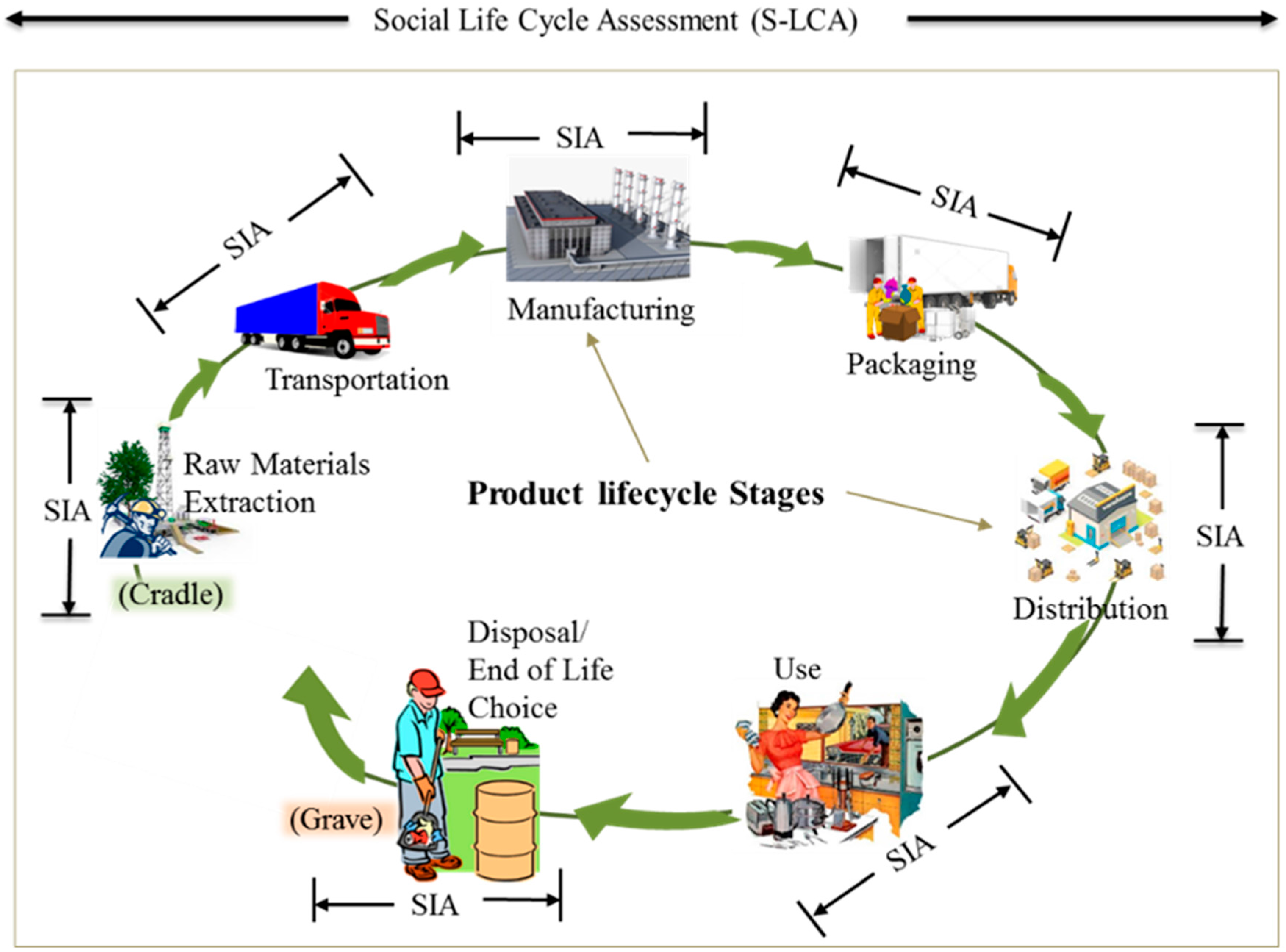
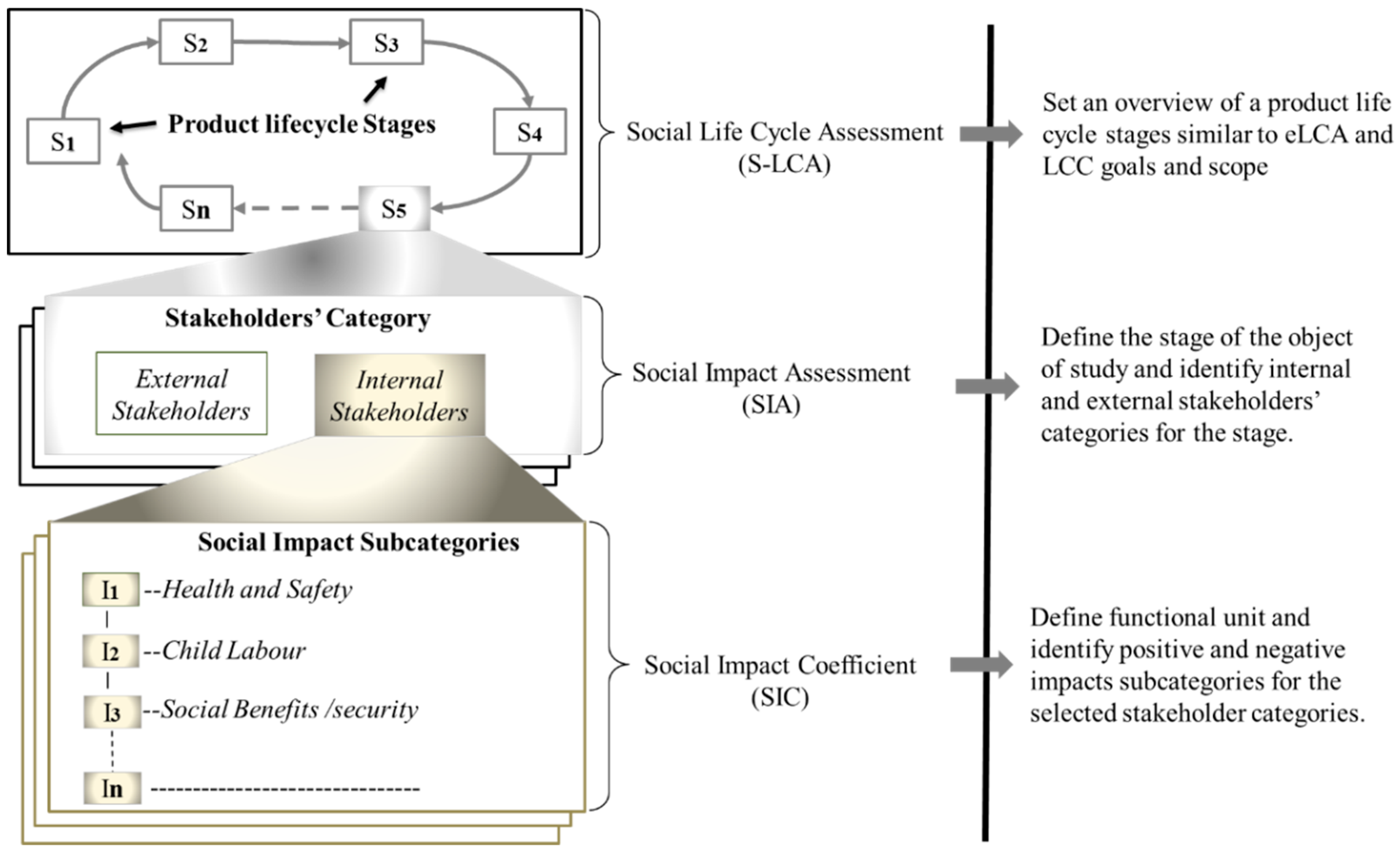
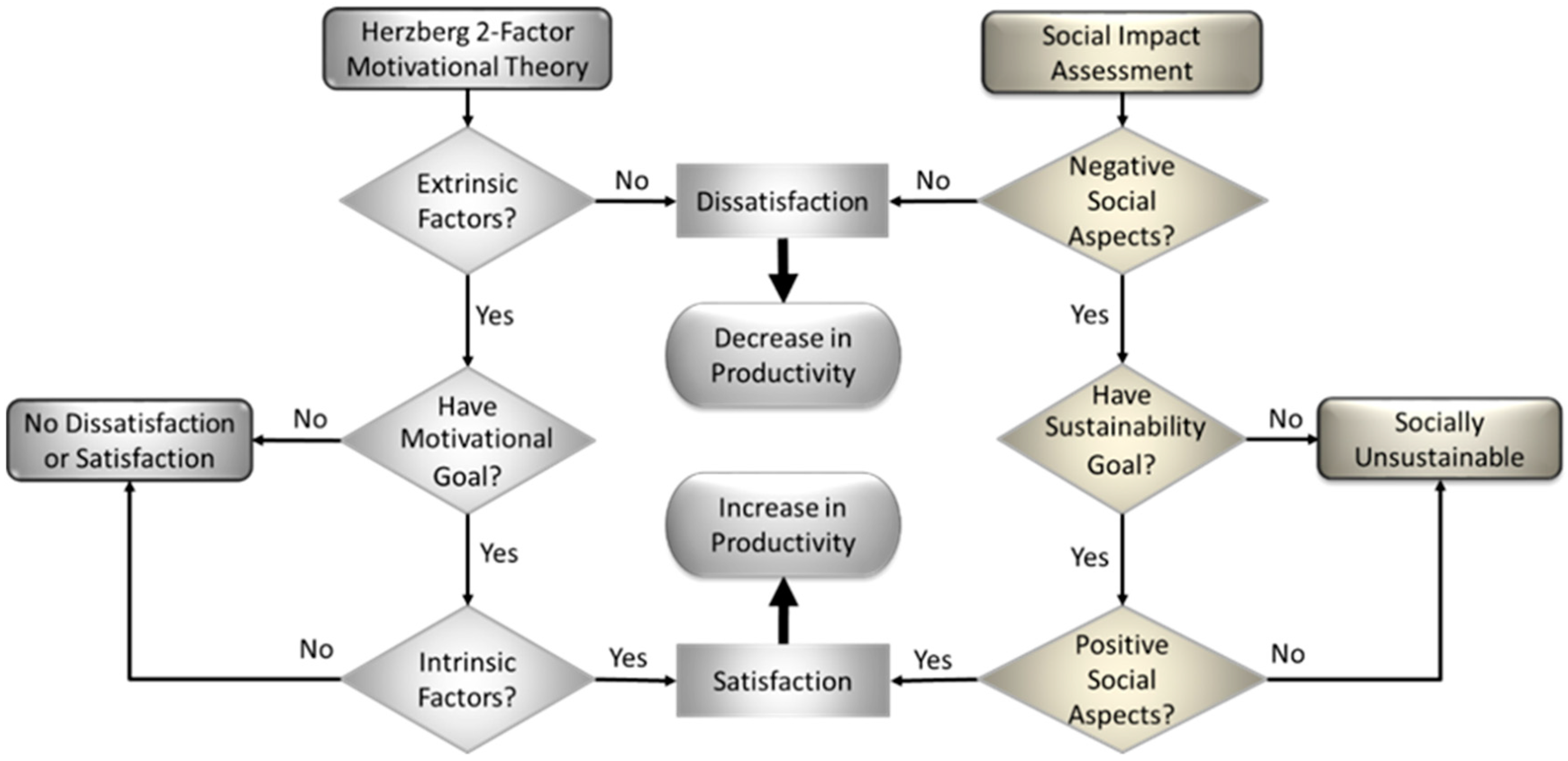
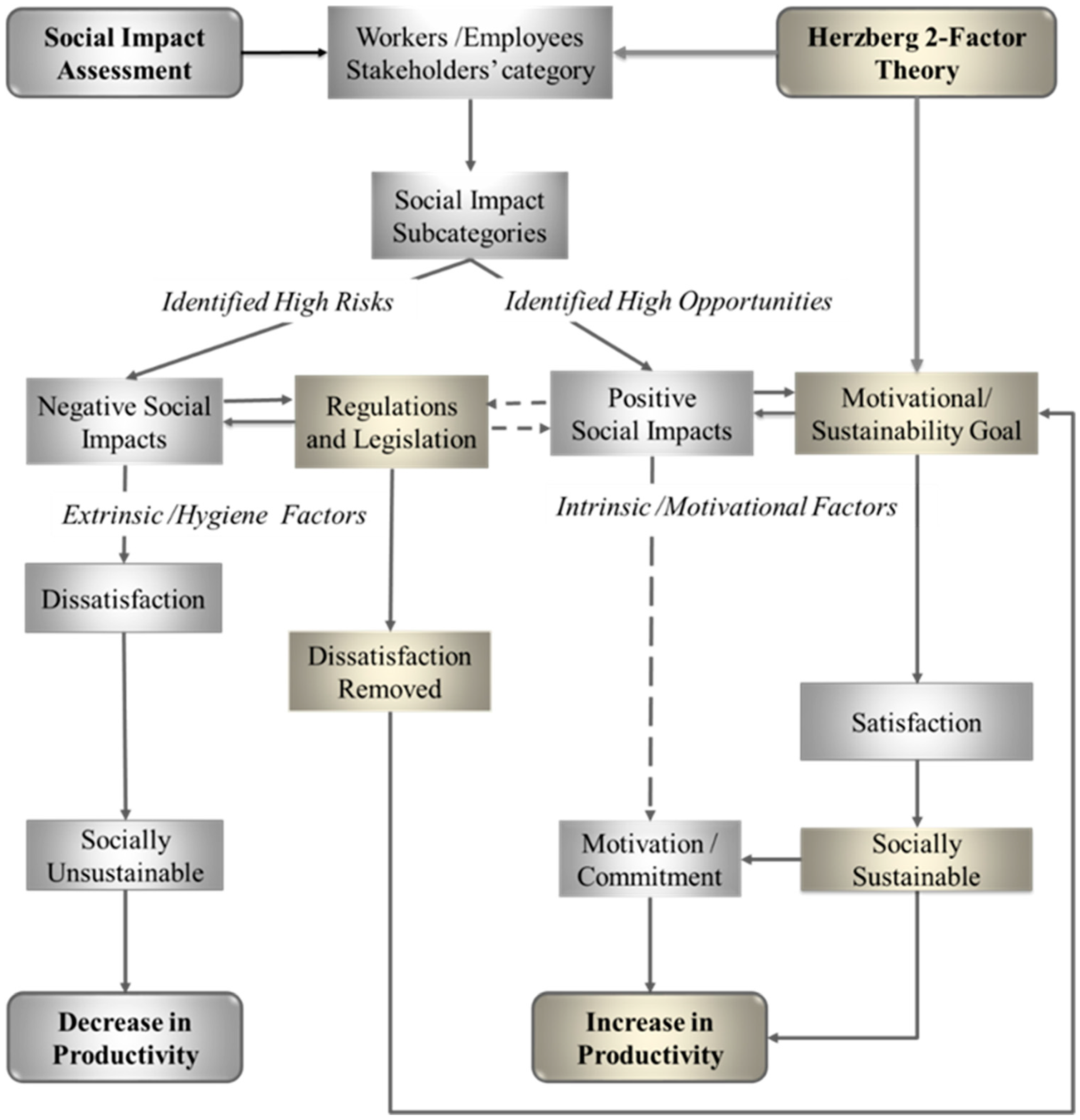
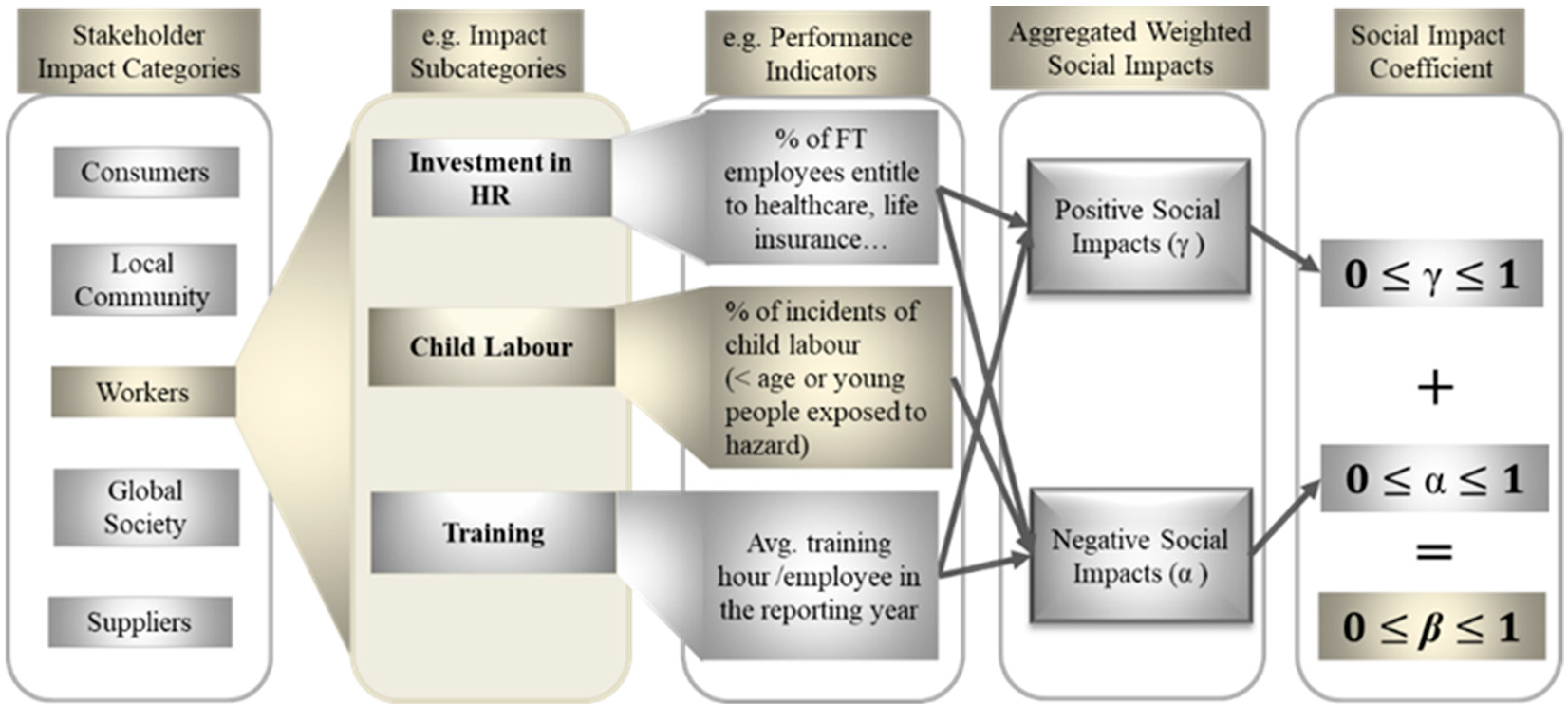
| Stakeholder Categories | Impacts Subcategories |
|---|---|
| Workers (Employees) | Investment on HR, freedom of association and collective bargaining, child and forced labour, fair salary, working hours, equal opportunities/discrimination, health & safety, social initiatives, social benefits/ security, training |
| Consumers–(supply chain and end users) | Health and safety, feedback mechanism, consumer privacy, transparency, end of life responsibility |
| Local community | Access to material resources, access to immaterial resources, delocalization and migration, cultural heritage, safe and healthy living conditions, respect for indigenous rights, community engagement, local employment, secure living conditions |
| Society–(national and global) | Public commitments to sustainability issues, contribution to economic development, prevention and mitigation of armed conflicts, technology development, Corruption |
| Value chain actors-suppliers (not including end-consumers) | Fair competition, promoting social responsibility, supplier relationships, respect for intellectual property rights |
| Impact Subcategories | Descriptions of Indicators | Impact Types |
|---|---|---|
| Risks of the right to Freedom of Association and collective bargaining | i. Violation of workers’ rights to exercise freedom of association or collective bargaining ii. Right of Association Policy in place | Negative (Regulated) |
| Risk of incidents of Child labour | a. Operations and suppliers considered having significant risk for incidents of: i. Child labour; ii. Young workers exposed to hazardous work. b. Measures taken by the organization to contribute to the effective abolition of child labour (e.g., policies against child labour) | Negative (Regulated) |
| Elimination of forced and compulsory labour | a. Operations and suppliers considered having significant risk for incidents of forced or compulsory labour either in terms of i. Type of operation (such as manufacturing plant) and supplier; ii. Countries or geographic areas with operations and suppliers considered at risk. b. Measures taken by the organization to the elimination of all forms of forced or compulsory labour (e.g., Policies against forced labour) | Negative (Regulated) |
| Job Creation | i. Work hour created per year ii. Fair salary compare to similar industries | Positive (Unregulated) |
| Equal opportunities/non-discrimination | i. Diversity of governance bodies and employees ii. Non-gender bias and equal opportunity iii. Ratio of basic salary of men to women iii. Availability of equality policy and training of staff on relevant codes and guidelines related to discrimination and equality | Negative (Regulated) |
| Occupational Health & Safety Management | i. Respect for workers right; ii. Injury and Absentee rates; iii. High-risk work or work environment; iv. Formal Health and safety agreement with trade union v. RIDDOR | Negative (Regulated) |
| Social Initiatives | i. Provision of social amenities onsite for workers ii. Onsite social events and outing iii. Recognition and Award events | Positive (Unregulated) |
| Investment in Human Resources (Social benefits/social security) | The number of full-time staff entitle to: I. Life insurance; ii. Healthcare; iii. Disability and invalidity coverage; iv. Parental leave; v. Retirement provision; vi. Stock ownership | Positive (Regulated) |
| Labour & Management Relations (Effective Communication) | i. Minimum notice period provided to employees and their representatives prior to the implementation of significant operational changes. ii. Notice period and provisions for consultation and negotiation are specified in collective agreements | Negative (Regulated) |
| Training | i. Average hours of training available to the employees per year ii. Programmes for skills upgrade and development iii. Regular Performance Review/Appraisal of employees | Positive (Regulated) |
Goal & Scope
| |||
| Stakeholder Category: Employees/Workers | |||
| Selected Impact Subcategories | Indicators (Ref: GRI, 2016 Equations) | Impact Types | |
| S1 | Investment in Human Resources | Aggregated percentage of FT employee benefits | +Ve & −Ve |
| S2 | Onsite Social Initiatives | Number of social amenities on site | +Ve |
| S3 | Training and Education | Average training hour per employee | +Ve |
| S4 | Labour /Management Relations | Effectiveness of labour/management relations | +Ve & −Ve |
| S5 | Occupational Health and Safety | Percentage of workers representatives at formal joint H & S meetings | −Ve |
| S6 | Freedom of association and collective bargaining | Risk of right to exercise freedom of association or collective bargaining | +Ve & −Ve |
| S7 | Diversity and Equal Opportunity | Ratio of basic salary of men to women | +Ve & −Ve |
| S8 | Non-Discrimination | Effective Non-discrimination policy and procedure | −Ve |
| S9 | Child Labour | Risk for incidents of child labour | −Ve |
| S10 | Forced or Compulsory Labour | Risk for incidents of slave or bond labour | −Ve |
| Graded Social Scores of Aggregated Social Weights (Scale-Based Referencing) | ||
|---|---|---|
| Aspects Counts (Number of Occurrence): | 6 | 8 |
| Social Aspects | Positive Aspects ( | Negative Aspects () |
| S1 | 6 | 3 |
| S2 | 7 | |
| S3 | 8 | |
| S4 | 7 | 7 |
| S5 | 4 | |
| S6 | 5 | 8 |
| S7 | 4 | 6 |
| S8 | 6 | |
| S9 | 9 | |
| S10 | 9 | |
| Total Weighted Values | 37 | 52 |
| Total Highest Possible Weighted Values | (6 × 9) = 54 | (8 × 9) = 72 |
| Percentage of Average weighted values | 68.52% | 72.22% |
| Ratio of Social Aspect Types | 0.4286 | 0.5714 |
| Relative Social Impacts Index | 0.2937 | 0.4127 |
| Social Impact Coefficient | ||
© 2018 by the authors. Licensee MDPI, Basel, Switzerland. This article is an open access article distributed under the terms and conditions of the Creative Commons Attribution (CC BY) license (http://creativecommons.org/licenses/by/4.0/).
Share and Cite
Gbededo, M.A.; Liyanage, K. Identification and Alignment of the Social Aspects of Sustainable Manufacturing with the Theory of Motivation. Sustainability 2018, 10, 852. https://doi.org/10.3390/su10030852
Gbededo MA, Liyanage K. Identification and Alignment of the Social Aspects of Sustainable Manufacturing with the Theory of Motivation. Sustainability. 2018; 10(3):852. https://doi.org/10.3390/su10030852
Chicago/Turabian StyleGbededo, Mijoh A., and Kapila Liyanage. 2018. "Identification and Alignment of the Social Aspects of Sustainable Manufacturing with the Theory of Motivation" Sustainability 10, no. 3: 852. https://doi.org/10.3390/su10030852
APA StyleGbededo, M. A., & Liyanage, K. (2018). Identification and Alignment of the Social Aspects of Sustainable Manufacturing with the Theory of Motivation. Sustainability, 10(3), 852. https://doi.org/10.3390/su10030852





